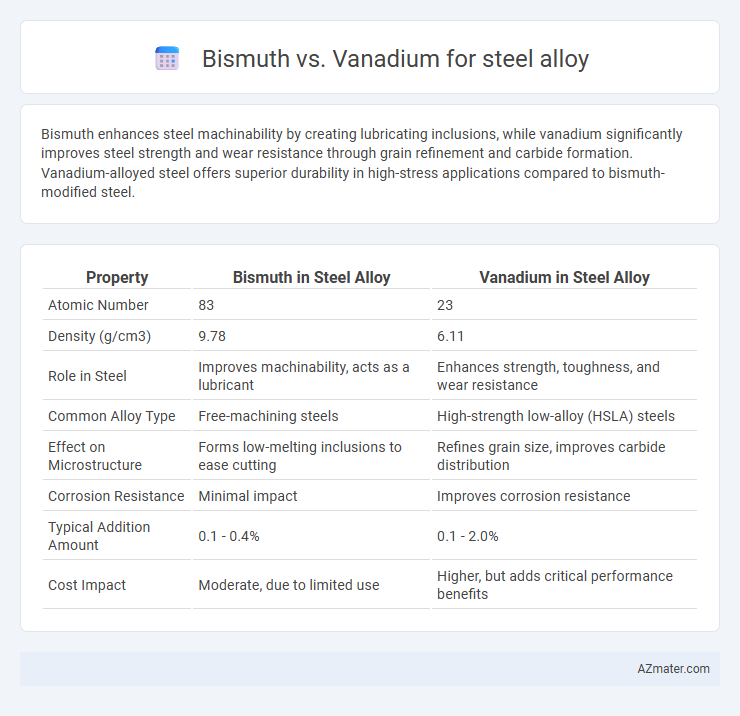Bismuth enhances steel machinability by creating lubricating inclusions, while vanadium significantly improves steel strength and wear resistance through grain refinement and carbide formation. Vanadium-alloyed steel offers superior durability in high-stress applications compared to bismuth-modified steel.
Table of Comparison
| Property | Bismuth in Steel Alloy | Vanadium in Steel Alloy |
|---|---|---|
| Atomic Number | 83 | 23 |
| Density (g/cm3) | 9.78 | 6.11 |
| Role in Steel | Improves machinability, acts as a lubricant | Enhances strength, toughness, and wear resistance |
| Common Alloy Type | Free-machining steels | High-strength low-alloy (HSLA) steels |
| Effect on Microstructure | Forms low-melting inclusions to ease cutting | Refines grain size, improves carbide distribution |
| Corrosion Resistance | Minimal impact | Improves corrosion resistance |
| Typical Addition Amount | 0.1 - 0.4% | 0.1 - 2.0% |
| Cost Impact | Moderate, due to limited use | Higher, but adds critical performance benefits |
Introduction: Bismuth and Vanadium in Steel Alloys
Bismuth and vanadium serve distinct functions in steel alloys, influencing mechanical properties and performance. Bismuth acts primarily as a machinability enhancer, promoting chip breakage and reducing tool wear, whereas vanadium functions as a microalloying element that refines grain structure and improves hardness, strength, and corrosion resistance. The choice between bismuth and vanadium depends on the specific steel grade requirements, balancing machinability and structural integrity.
Chemical Properties Comparison: Bismuth vs Vanadium
Bismuth, a post-transition metal with an atomic number of 83, exhibits low toxicity, high density, and a melting point of 271.5degC, making it suitable as a castability enhancer in steel alloys by improving machinability without compromising environmental safety. Vanadium, a transition metal with atomic number 23, possesses a higher melting point of 1910degC and forms stable carbides that significantly increase steel strength, toughness, and wear resistance through grain refinement and precipitation hardening. The distinct chemical properties of bismuth and vanadium influence their roles in steel alloy composition, where bismuth improves machinability while vanadium enhances mechanical performance and durability.
Effects on Steel Microstructure
Bismuth in steel alloys promotes machinability by forming low-melting-point inclusions, which create microstructural discontinuities that facilitate chip separation without significantly altering the grain structure. Vanadium acts as a strong microalloying element, refining grain size through precipitation strengthening of vanadium carbides and nitrides, enhancing toughness and wear resistance. The contrasting effects highlight bismuth's role in improving machining efficiency while vanadium primarily contributes to microstructural strengthening and improved mechanical properties.
Influence on Mechanical Strength
Bismuth in steel alloys enhances machinability by creating microscopic inclusions that act as lubricants but slightly reduce mechanical strength compared to pure steel. Vanadium significantly improves mechanical strength through grain refinement and the formation of vanadium carbides, which increase hardness and tensile strength. Steel alloys with vanadium exhibit superior toughness and wear resistance, making them ideal for high-strength applications.
Impact on Corrosion Resistance
Bismuth in steel alloys primarily improves machinability without significantly enhancing corrosion resistance, as it tends to form non-protective surface films. Vanadium contributes to corrosion resistance by forming stable carbides and nitrides that refine grain structure and enhance passive film formation, leading to improved durability in aggressive environments. Vanadium's role in promoting a more uniform and protective oxide layer makes it more effective than bismuth for steel alloy corrosion resistance.
Role in Machinability of Steel
Bismuth in steel alloys acts as an effective machinability agent by creating a low-melting-point phase that facilitates chip breaking and reduces tool wear, enhancing cutting performance. Vanadium contributes to steel strength and wear resistance through carbide formation but typically reduces machinability due to increased hardness and toughness. The selective addition of bismuth provides improved machinability in steel without significantly compromising mechanical properties, unlike vanadium which prioritizes strength over ease of machining.
Environmental and Health Considerations
Bismuth in steel alloys offers environmental advantages due to its non-toxic and biodegradable nature, reducing hazardous waste compared to traditional heavy metals. Vanadium, while enhancing steel strength and fatigue resistance, poses health risks during manufacturing due to its toxicity and potential for respiratory exposure. Choosing bismuth improves workplace safety and minimizes ecological impact from alloy production and recycling processes.
Cost and Availability of Alloying Elements
Bismuth is generally more expensive and less abundant than vanadium, making it a costlier choice for steel alloying despite its effectiveness in improving machinability. Vanadium is widely available and commonly sourced as a byproduct of steel production, offering a more economical option for enhancing strength and wear resistance in alloys. The cost-efficiency and availability of vanadium contribute to its preferred use in large-scale steel manufacturing over bismuth.
Industrial Applications and Case Studies
Bismuth in steel alloys enhances machinability by creating a softer, more easily cut material without compromising strength, making it ideal for automotive and heavy machinery components requiring precise manufacturing. Vanadium significantly improves steel's toughness, wear resistance, and heat resistance, which is critical in structural applications such as bridges, pipelines, and aerospace parts exposed to extreme conditions. Case studies reveal that bismuth-alloyed steels reduce tooling costs and improve surface finish in high-volume machining, while vanadium-containing steels extend service life and performance in demanding industrial environments.
Conclusion: Choosing Between Bismuth and Vanadium
Bismuth offers improved machinability and environmental benefits due to its non-toxic nature, making it ideal for free-machining steel alloys. Vanadium enhances steel strength, wear resistance, and toughness, critical for high-performance structural applications. Selecting between Bismuth and Vanadium depends on prioritizing machinability and eco-friendliness versus mechanical strength and durability in steel alloy design.

Infographic: Bismuth vs Vanadium for Steel alloy
 azmater.com
azmater.com